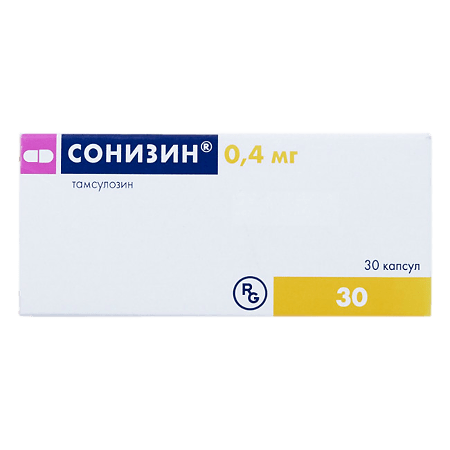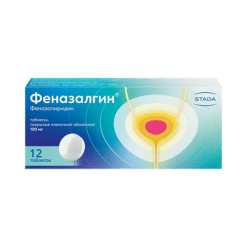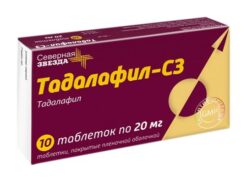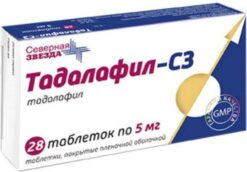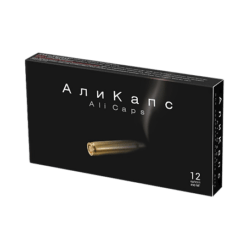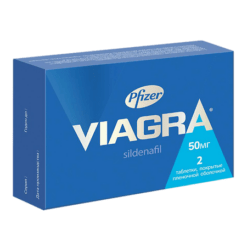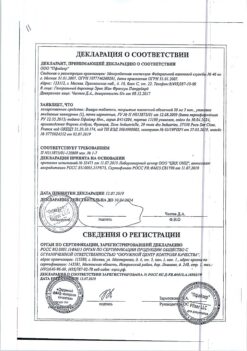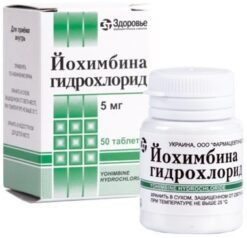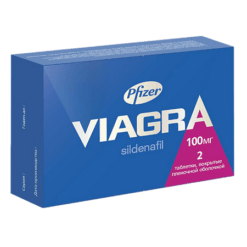No products in the cart.
Sonisin, 0.4 mg 30 pcs
€11.75 €10.28
Description
Sonisin is an alpha1-adrenoblocker
Pharmacodynamics
Tamsulosin selectively and competitively blocks postsynaptic α1A-adrenoreceptors located in the smooth muscle of the prostate, bladder neck and prostatic part of the urethra, as well as α1D-adrenoreceptors mainly located in the bladder body.
This leads to reduction of tone of the smooth muscles of the prostate, bladder neck and prostatic part of the urethra and improvement of detrusor function.
This decreases symptoms of obstruction and irritation associated with benign prostatic hyperplasia. As a rule, the therapeutic effect develops 2 weeks after the start of therapy, although some patients have less symptoms after the first dose.
The ability of tamsulosin to affect α1A adrenoreceptors is 20 times greater than its ability to interact with α1B adrenoreceptors located in vascular smooth muscle.
This high selectivity ensures that the drug does not cause any clinically significant reduction in systemic arterial blood pressure (BP) in both patients with arterial hypertension and patients with normal baseline BP.
Pharmacokinetics
Intake
After oral administration, tamsulosin is rapidly and almost completely absorbed from the gastrointestinal tract. The bioavailability of the drug is about 100%.
After a single oral dose of 400 mcg the Cmax of the active substance in plasma is reached after 6 hours.
Distribution
At equilibrium (after 5 days of a course of administration) the Cmax values of the active substance in plasma are 60-70% higher than Cmax after a single dose of the drug.
The binding to plasma proteins is 99%. Tamsulosin has a low volume of distribution (approximately 0.2 L/kg).
Metabolism
Tamsulosin does not undergo a “first pass” effect and is slowly biotransformed in the liver to form pharmacologically active metabolites that remain highly selective to α1A-adrenoreceptors. Most of the active substance is present in the blood unchanged.
Elimination
Tamsulosin is excreted by the kidneys, 9% of the dose is excreted unchanged.
The T1/2 of tamsulosin in single administration is 10 hours, after multiple administration – 13 hours, the final elimination half-life is 22 hours.
Indications
Indications
Treatment of dysuric disorders caused by benign prostatic hyperplasia.
Pharmacological effect
Pharmacological effect
Sonisin – alpha1-blocker
Pharmacodynamics
Tamsulosin selectively and competitively blocks postsynaptic α1A-adrenergic receptors located in the smooth muscles of the prostate gland, bladder neck and prostatic urethra, as well as α1D-adrenergic receptors, mainly located in the body of the bladder.
This leads to a decrease in the tone of the smooth muscles of the prostate gland, bladder neck and prostatic urethra and improved detrusor function.
This reduces the symptoms of obstruction and irritation associated with benign prostatic hyperplasia. As a rule, the therapeutic effect develops 2 weeks after starting the drug, although some patients experience a decrease in the severity of symptoms after taking the first dose.
The ability of tamsulosin to act on α1A-adrenergic receptors is 20 times greater than its ability to interact with α1B-adrenergic receptors, which are located in vascular smooth muscle.
Due to this high selectivity, the drug does not cause any clinically significant decrease in systemic blood pressure (BP) both in patients with arterial hypertension and in patients with normal baseline blood pressure.
Pharmacokinetics
Suction
After oral administration, tamsulosin is quickly and almost completely absorbed from the gastrointestinal tract. Bioavailability of the drug is about 100%.
After a single dose of the drug orally at a dose of 400 mcg, Cmax of the active substance in plasma is achieved after 6 hours.
Distribution
At steady state (after 5 days of course administration), the Cmax values of the active substance in the blood plasma are 60-70% higher than Cmax after a single dose of the drug.
Plasma protein binding – 99%. Tamsulosin has a small volume of distribution (approximately 0.2 L/kg).
Metabolism
Tamsulosin does not undergo the “first pass” effect and is slowly biotransformed in the liver to form pharmacologically active metabolites that retain high selectivity for α1A-adrenergic receptors. Most of the active substance is present in the blood unchanged.
Removal
Tamsulosin is excreted by the kidneys, 9% of the dose is excreted unchanged.
T1/2 of tamsulosin with a single dose is 10 hours, after multiple doses is 13 hours, the final half-life is 22 hours.
Special instructions
Special instructions
Like other α1-blockers, tamsulosin can cause a decrease in blood pressure, in rare cases causing syncope. At the first signs of orthostatic hypotension (dizziness, weakness), it is necessary to sit or lay the patient down until the symptoms disappear.
Treatment with tamsulosin should be preceded by a preliminary examination of the patient in order to exclude any other disease that occurs with the same symptoms as benign prostatic hyperplasia. Treatment should be preceded by a preliminary digital rectal examination of the prostate and measurement of prostate specific antigen (PSA) levels, which are repeated regularly later in the course of treatment.
During the treatment period, it is necessary to refrain from engaging in potentially hazardous activities that require increased concentration and speed of psychomotor reactions.
Active ingredient
Active ingredient
Tamsulosin
Composition
Composition
Active ingredient:
Contraindications
Contraindications
Hypersensitivity to tamsulosin hydrochloride or any other component of Sonisin.
With caution: chronic renal failure (decrease in creatinine clearance below 10 ml/min), arterial hypotension (including orthostatic), severe liver failure.
Side Effects
Side Effects
Rarely – headache, dizziness, asthenia, sleep disturbances (drowsiness or insomnia), retrograde ejaculation, decreased libido, back pain, rhinitis; in isolated cases – orthostatic hypotension, tachycardia, palpitations, chest pain.
From the digestive system: in rare cases – nausea, vomiting, constipation or diarrhea. In extremely rare cases, hypersensitivity reactions – skin rash, itching, angioedema.
Interaction
Interaction
Cimetidine increases the concentration of tamsulosin in plasma, furosemide reduces it (has no significant clinical significance, dosage changes are not required).
Diclofenac and indirect anticoagulants increase the elimination of tamsulosin.
Diazepam, propranolol, trichlormethiazide, chlormadinone, amitriptyline, diclofenac, glibenclamide, simvastatin and warfarin do not change the free fraction of tamsulosin in human plasma in vitro. In turn, tamsulosin does not change the free fractions of diazepam, propranolol, trichlormethiazide and chlormadinone.
In vitro studies showed no interaction at the level of hepatic metabolism with amitriptylipe, salbutamol, glibenclamide and finasteride.
Other alpha1-blockers, acetylcholinesterase inhibitors, alprostadil, anesthetics, diuretics, levodopa, antidepressants, beta-blockers, slow calcium channel blockers, nitrates and ethanol may increase the severity of the hypotensive effect of tamsulosin.
Overdose
Overdose
Cases of acute overdose have not been described.
Symptoms: acute hypotension and compensatory tachycardia are theoretically possible.
Treatment: The patient should be laid down to restore blood pressure and normalize heart rate. Cardiotropic therapy is carried out. Renal function should be monitored and general supportive care should be used.
If symptoms persist, volume-replacing solutions and vasoconstrictor drugs should be administered.
To prevent further absorption of tamsulosin, gastric lavage, activated charcoal or an osmotic laxative may be taken.
Dialysis is not effective because tamsulosin binds tightly to plasma proteins.
Storage conditions
Storage conditions
At 15–30 °C
Shelf life
Shelf life
3 years
Manufacturer
Manufacturer
Gedeon Richter, Hungary
Additional information
| Shelf life | 3 years |
|---|---|
| Conditions of storage | At 15-30 °C |
| Manufacturer | Gedeon Richter, Hungary |
| Medication form | modified-release capsules |
| Brand | Gedeon Richter |
Related products
Buy Sonisin, 0.4 mg 30 pcs with delivery to USA, UK, Europe and over 120 other countries.

